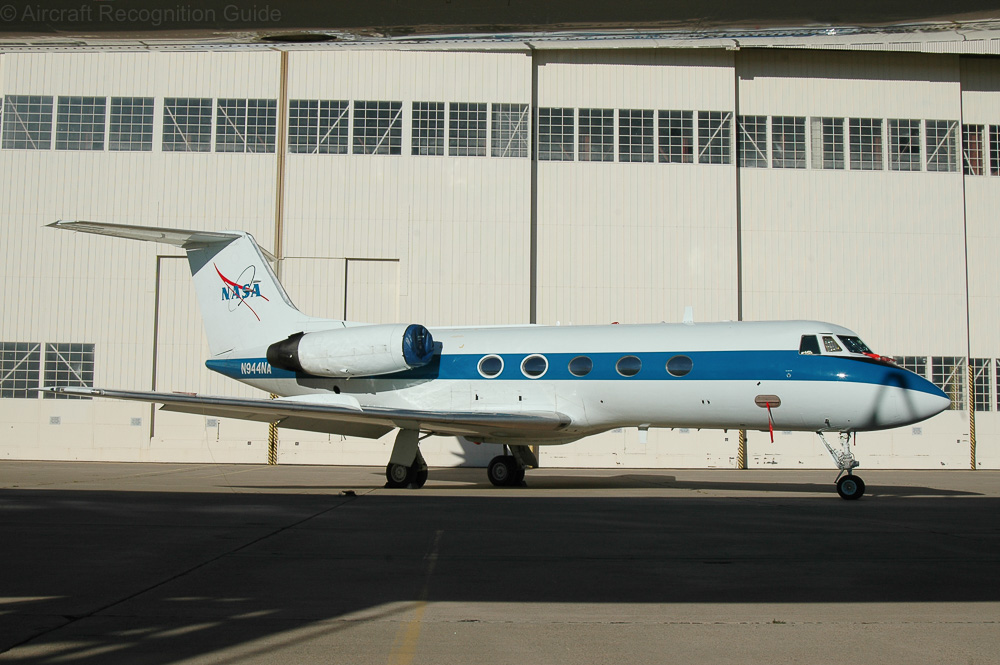
Grumman G.159 Gulfstream I
The Grumman Gulfstream I turboprop was one of the the first designed as a dedicated corporate aircraft. As such it can be regarded as the largest bizprop ever built, because after that there were only big jets, and only smaller props like the Beech King Air and Pilatus PC-12.
Grumman's model G.159 has five big oval cabin windows on each side, the same as which are in the Gulfstream jets nowadays. The shape of the engine nacelles is similar to that of the HS748 and YS-11, with a ring-shaped are intake and a bulge below the wings to house the landing gear. The Rolls Royce Dart engines power four bladed props. The G-I has six flat cockpit windows.
The Gulfstream I has six flat cockpit windows without eyebrow windows. The entrance door has built-in steps. Essentially the nose remained unchanged on the Gulfstream II jet.
The nacelles are slender and have a ring-shaped air intake at the front, typical for the Dart engines. Below the wings is a bulge in which the landing gear retracts. Note the characteristic Gulfstream oval cabin windows.
The swept vertical stabilizer of the G.159 has a small dorsal fin with intakes on both sides. Also note the exhaust of the APU, in front of the horizontal stabilizer.
Different versions
The different versions of the Gulfstream I can be identified by:
- the length of the fuselage
- the shape of the nose
- the absence of cabin windows
Gulfstream I
The original corporate/executive transport was at first simply named Gulfstream, but this became Gulfstream I when the Gulfstream II jet appeared. It has all the features described above in the general section.
One such VIP Gulfstream I was operated by the US Coast Coast with designation VC-4A.
The Aviation Group held an STC for a full cargo conversion. It has a cargo door at the same place as the optional one on passenger G-Is and the cabin windows ave been replaced with metal plugs. It has no different designation nor marketing name.
TC-4C
When the US Navy required a 'flying classroom' to train navigators for the A-6 Intruder fighters, nine Gulfstream Is were acquired. They have a large nose, in which the radar of the Intruder was placed. Their official designation was TC-4C, with name Academe, although this was not used often.
The big nose on the TC-4C Academe is hard to miss. It houses the radar of the Intruder fighter.
Gulfstream IC
While Grumman had tried to sell the G-I as commuter aircraft before, it did not succeed. Only after Gulfstream American had taken over, a stretched variant was offered. This Gulfstream IC, also reffered to as G.159C, has a 3.5 m longer fuselage with seven cabin windows on each side instead of five. Just five were converted from standard G-Is.
The stretched Gulfstream IC was used as commuter aircraft, but only five were built, all converted from standard G-Is. (photo JetPix/WikiMedia)
Confusion possible with
Hawker-Siddely HS748
The closest competitor in appearance is the HS748. That aircraft is a bit larger with more and smaller cabin windows, but the cockpit windows and nacelles are very similar. The trailing edge of the vertical stabiliser is swept forward.
NAMC YS-11
The YS-11 also has a similar appearance at first glance, but is significantly bigger and has many smaller cabin windows. So that is an easy call.
Saab 340
Another aircraft of similar size and same basic configuration is the Saab 340. However the four cockpit windows and lack of big oval windows already provide an easy way to not mix it up with a Saab 340.
Grumman G.1159 Gulfstream II
This may seem a strange entrance here at first, but leave out the jet engines, tail and wings and it is easy to mix up the G-I and G-II. The wings are placed more aft on the G-II than on the G-I.











